IEEE Transactions on Vehicular Technology, vol. 70, no. 5, IEEE, pp. 4001 - 4010, 05/2021. DOI
Abstract
New mobility paradigms have appeared in recent years, and everything suggests that some more are coming. This fact makes apparent the necessity of modernizing the road infrastructure, the signalling elements and the traffic management systems. Many initiatives have emerged around the term Intelligent Transport System (ITS) in order to define new scenarios and requirements for this kind of applications. We even have two main competing technologies for implementing Vehicular communication protocols (V2X), C-V2X and 802.11p, but neither of them is widely deployed yet.
One of the main barriers for the massive adoption of those technologies is governance. Current solutions rely on the use of a public key infrastructure that enables secure collaboration between the different entities in the V2X ecosystem, but given its global scope, managing such infrastructure requires reaching agreements between many parties, with conflicts of interest between automakers and telecommunication operators. As a result, there are plenty of use cases available and two mature communication technologies, but the complexity at the business layer is stopping the drivers from taking advantage of ITS applications.
Blockchain technologies are defining a new decentralized paradigm for most traditional applications, where smart contracts provide a straightforward mechanism for decentralized governance. In this work, we propose an approach for decentralized V2X (D-V2X) that does not require any trusted authority and can be implemented on top of any communication protocol. We also define a proof-of-concept technical architecture on top of a cheap and highly secure System-on-Chip (SoC) that could allow for massive adoption of D-V2X.
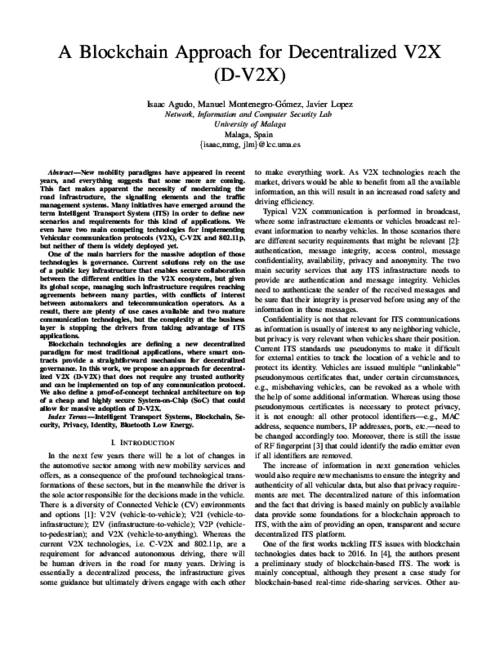
Computers & Security, vol. 39 (B), Elsevier, pp. 117-126, 11/2013. DOI
Abstract
Continuous authentication is mainly associated with the use of biometrics to guarantee that a resource is being accessed by the same user throughout the usage period. Wireless devices can also serve as a supporting technology for continuous authentication or even as a complete alternative to biometrics when accessing proximity-based services. In this paper we present the implementation of a secure, non-invasive continuous authentication scheme supported by the use of Wearable Wireless Devices (WWD), which allow users to gain access to proximity-based services while preserving their privacy. Additionally we devise an improved scheme that circumvents some of the limitations of our implementation.
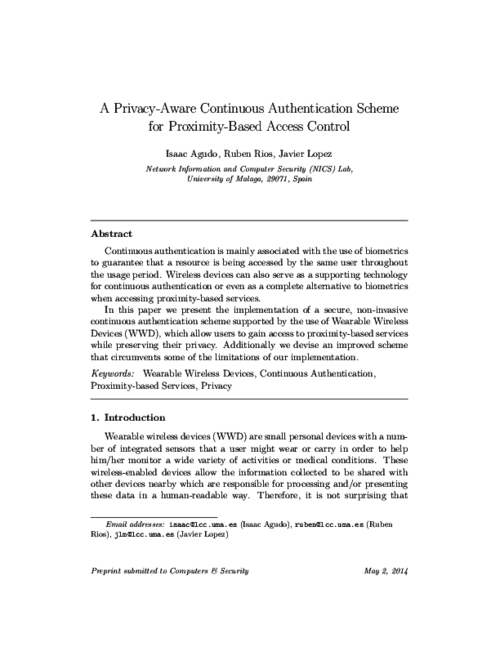
5th International Conference on Trust, Privacy and Security in Digital Business (TrustBus’08), LNCS 5185, Springer, pp. 28-37, 2008. DOI
Abstract
Trust is an important factor in any kind of network essential, for example, in the decision-making process. As important as the definition of trust is the way to compute it. In this paper we propose a model for defining trust based on graph theory and show examples of some simple operators and functions that will allow us to compute trust.
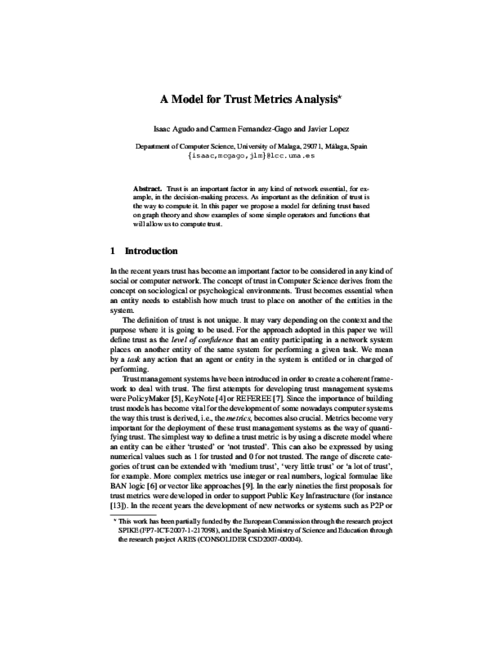
Fifth International Network Conference (INC’05), pp. 157-164, 2005.
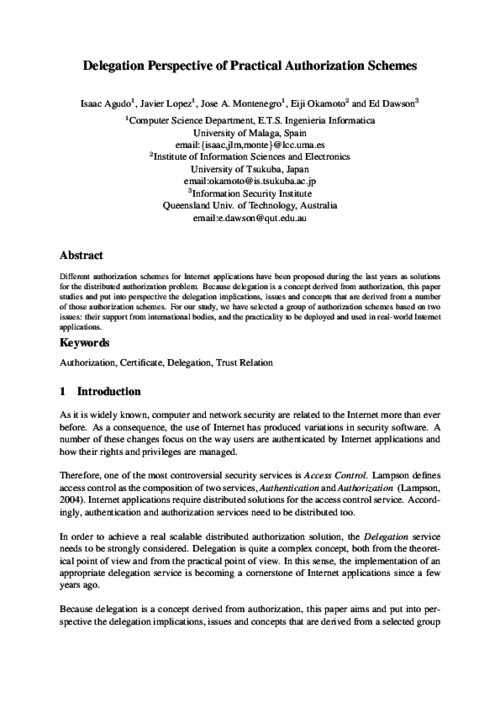
UPGRADE - The European Journal of the Informatics Professional, vol. 2010, CEPIS, pp. 6 - 12, 2010.
Abstract
There are many technologies for identity management available in the form of open specifications, open source tools and commercial applications. Currently, there are some competing standards for identity management. At the beginning SAML was the only viable choice with a higher enough acceptance level. Recently, another technology called WS-Federation has also gain some attention from the community. Although this technology is not as mature as SAML, it modular design gives it some advantages over SAML. It this work we mainly focus on the WS-Federation and the family of specifications that surround it.
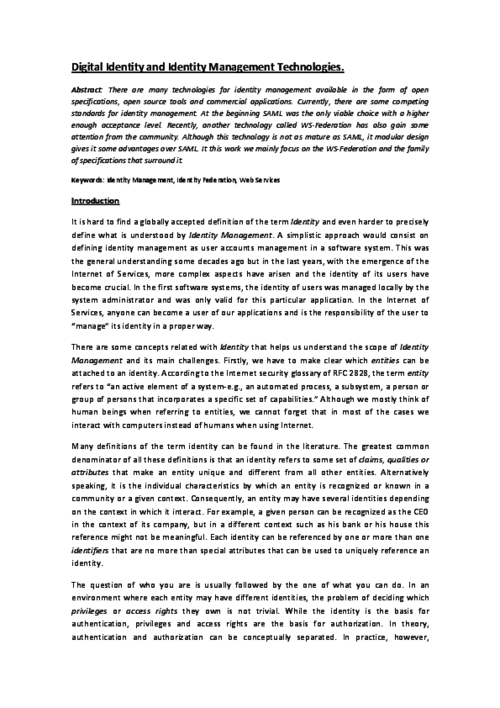
IX Reunión Española sobre Criptología y Seguridad de la información (RECSI’06), pp. 311-322, Septiembre, 2006.
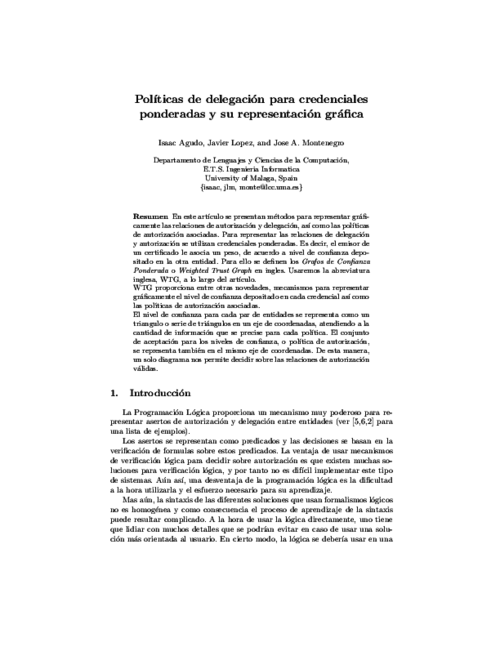
International Conference on Information Systems Education and Research (AIS SIGED 2019), 12/2019.
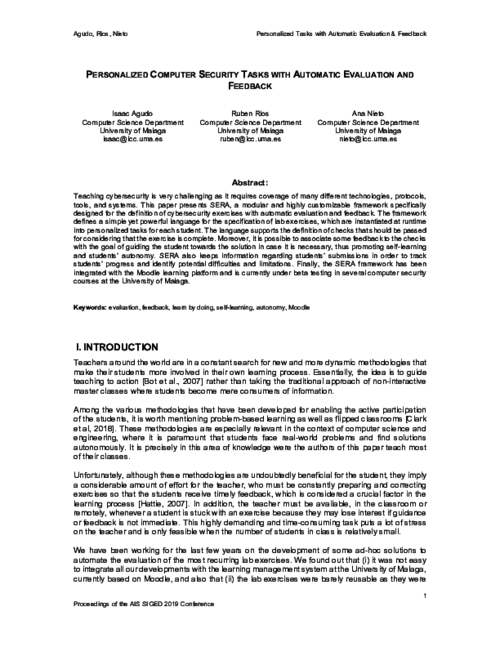
4th Workshop on Security and Trust Management (STM’08), ENTCS 224, Elsevier, pp. 3-12, 2008. DOI
Abstract
In this paper we propose a trust model, where besides considering trust and distrust, we also consider another parameter that measures the reliability on the stability of trust or distrust. The inclusion of this new parameter will allow us to use trust in a more accurate way. We consider trust is not static but dynamic and trust values can change along time. Thus, we will also take time into account, using it as a parameter of our model. There is very little work done about the inclusion of time as an influence on trust. We will show the applicability of our model in the scenario of the process of reviewing papers for a conference. Sometimes for these kind of processes the Chair of the conference should first find the suitable reviewers. He can make this selection by using our model. Once the reviewers are selected they send out their reviews to the Chair who can also use our model in order to make the final decision about acceptance of papers.
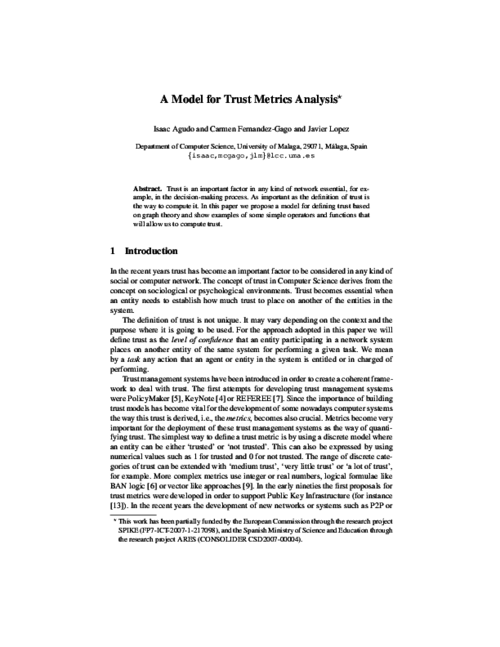
3th International Conference on Trust Management (iTRUST’05), LNCS 3477, Springer, pp. 9-22, May, 2005. DOI
Abstract
Logic languages establish a formal framework to solve authorization and delegation conflicts. However, we consider that a visual representation is necessary since graphs are more expressive and understandable than logic languages. In this paper, and after overviewing previous works using logic languages, we present a proposal for graph representation of authorization and delegation statements. Our proposal is based on Varadharajan et al. solution, though improve several elements of that work. We also discuss about the possible implementation of our proposal using attribute certificates.
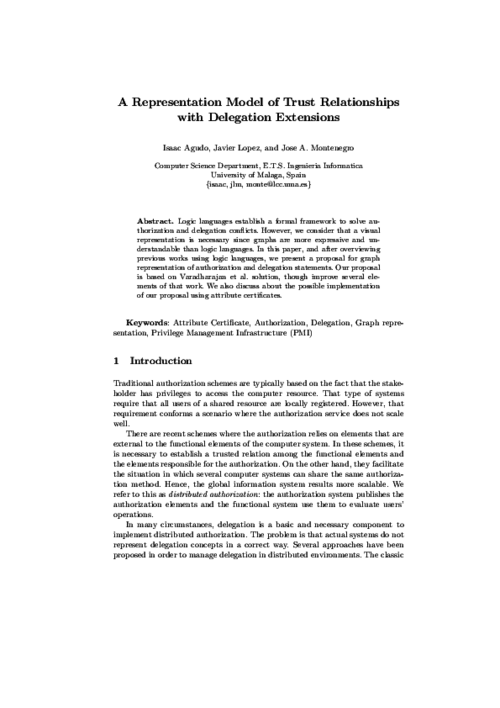
Computers and Mathematics with Applications, vol. 60, Elsevier, pp. 209-216, July, 2010. DOI
Abstract
When interactions among users of a system have to take place, for example, over the internet, establishing trust relationships among these users becomes crucial. However, the way this trust is established depends to a certain extent on the context where the interactions take place. Most of the time, trust is encoded as a numerical value that might not be very meaningful for a not very experienced user. In this paper we propose a model that takes into account the semantic and the computational sides of trust. This avoids users having to deal directly with the computational side; they instead deal with meaningful labels such as Bad or Good in a given context.
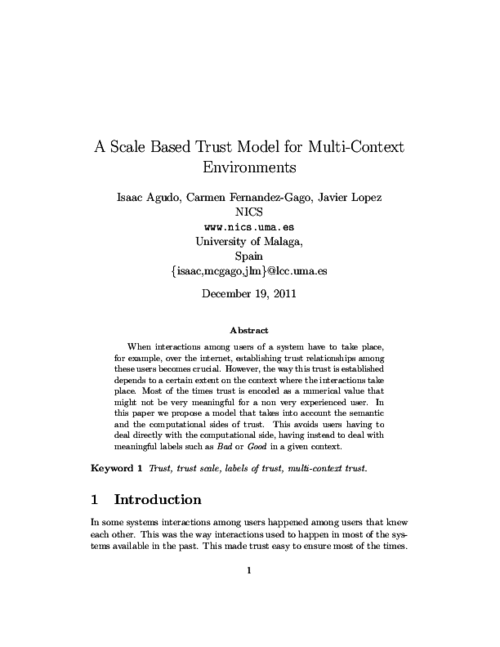
3rd international conference on Mobile multimedia communications (MobiMedia ’07), ICST, pp. 50:1–50:6, 2007.
Abstract
In this paper we simulate an authorization and delegation system using knowledge based technology. This proposal is part of a visual tool that is intended to be an implementation of the theoretical model weighted trust graph (WTG). A brief description of WTG Model and its associated tool is included in the text. In essence, the model is based on the inclusion of real numbers between zero and one in certificates to represent the trust level between the entities involved in them. This trust level is used to control delegation. Moreover, attributes from di_erent domains may be interrelated, so attribute delegation is also taken into account. The proposed Simulation Engine supports one directional and bidirectional search algorithms.

10th International IFIP Summer School on Privacy and Identity Management, pp. 187-204, 2016. DOI
Abstract
Transparency and verifiability are necessary aspects of accountability, but care needs to be taken that auditing is done in a privacy friendly way. There are situations where it would be useful for certain actors to be able to make restricted views within service provision chains on accountability evidence, including logs, available to other actors with specific governance roles. For example, a data subject or a Data Protection Authority (DPA) might want to authorize an accountability agent to act on their behalf, and be given access to certain logs in a way that does not compromise the privacy of other actors or the security of involved data processors. In this paper two cryptographic-based techniques that may address this issue are proposed and assessed.
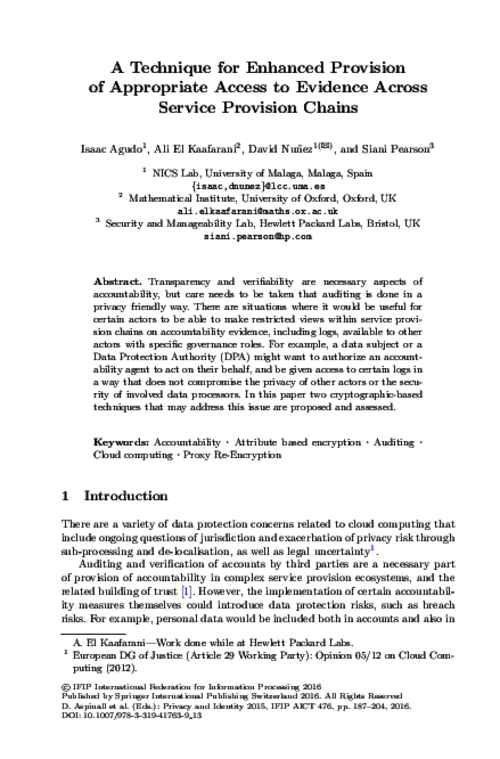
Mobile Networks and Applications, vol. 13, no. 3-4, Springer, pp. 398-410, August, 2008. DOI
Abstract
When delegation is implemented using the attribute certificates in a Privilege Management Infrastructure (PMI), it is possible to reach a considerable level of distributed functionality. However, the approach is not flexible enough for the requirements of ubiquitous environments. The PMI can become a too complex solution for devices such as smartphones and PDAs, where resources are limited. In this work we present an approach to solve the previous limitations by defining a second class of attributes, called domain attributes, which are managed directly by users and are not right under the scope of the PMI, thus providing a light solution for constrained devices. However, we relate the two classes of attributes are related by defining a simple ontology. While domain attribute credentials are defined using SAML notation, global attributes are defined using X.509 certificates. For this reason, we additionally introduce XSAML so that both kinds of credentials are integrated. We also introduce the concept of Attribute Federation which is responsible for supporting domain attributes and the corresponding ontology.
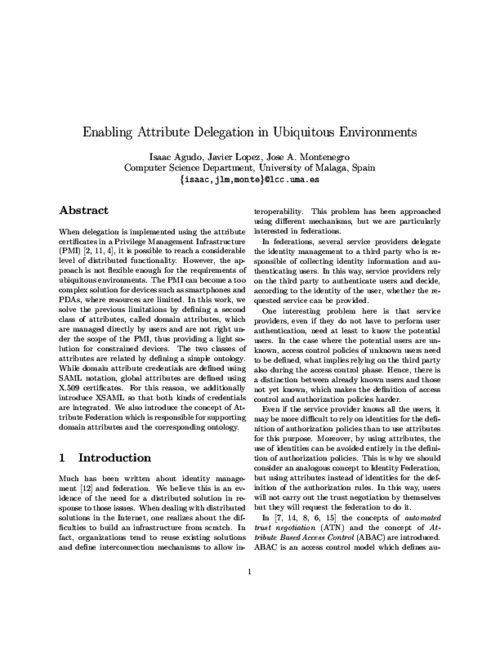
ERCIM News, no. 63, ERCIM, pp. 33-34, October, 2005.
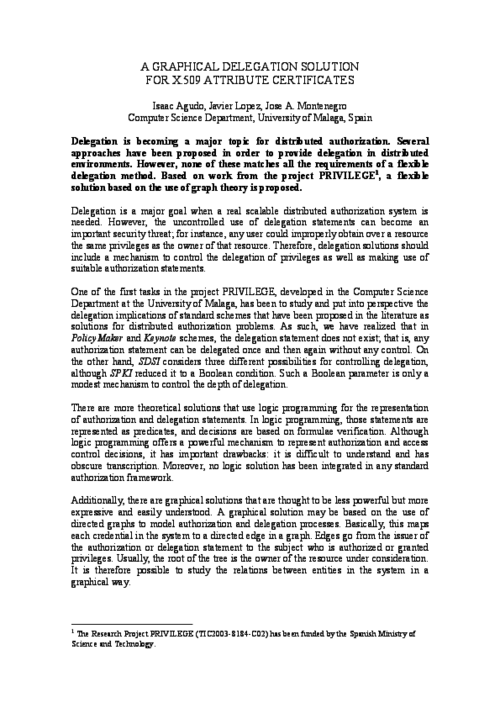
XI Reunión Española sobre Criptología y Seguridad de la Información (RECSI 2010), September, 2010.
Abstract
En la actualidad, cada vez son más frecuentes los ataques software mediante la utilización de malware o sustitución de programas (o componentes) en los repositorios a los cuales los usuarios finales (o máquinas) acceden. Esta situación se ve de alguna manera acentuada con el dinamismo existente en la programación y ejecución de estos componentes, en la que distintos desarrolladores pueden participar para desplegar un determinado servicio o parte de él. Por ello, en este artículo se presenta una solución para la distribución de código de forma segura usando OpenID y firmas con certificados de clave pública de corta duración. De esta forma, se consigue un compromiso de seguridad que permite distribuir código firmado sin la necesidad de que los desarrolladores dispongan a priori de un certificado específico. Presentamos además algunos detalles acerca de la implementación realizada para hacer realidad este diseño.
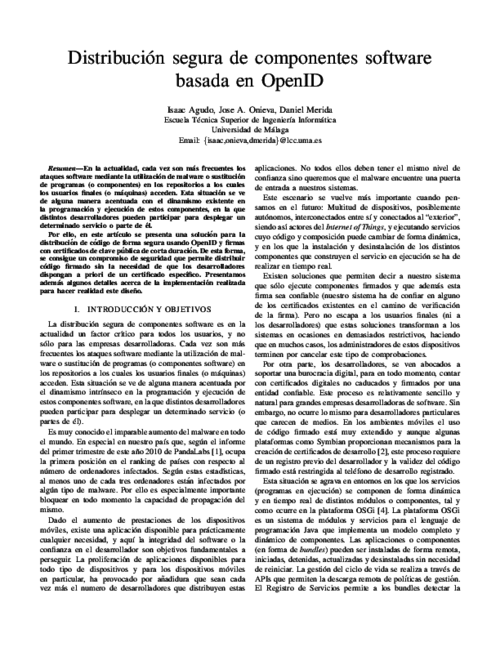
3rd international conference on Mobile multimedia communications (MobiMedia ’07), ICST, pp. 43:1–43:6, 2007.
Abstract
When delegation is implemented using the attribute certificates in a Privilege Management Infrastructure (PMI), this one reaches a considerable level of distributed functionality. However, the approach is not flexible enough for the requirements of ubiquitous environments. Additionally, the PMI can become a too complex solution for devices such as smartphones and PDAs, where resources are limited. In this work, we solve the previous limitations by defining a second class of attributes, called domain attributes, which are managed directly by users and are not right under the scope of the PMI, thus providing a light solution for constrained devices. The two classes of attributes are related by defining a simple ontology. We also introduce in the paper the concept of Attribute Federation which is responsible for supporting domain attributes and the corresponding ontology.
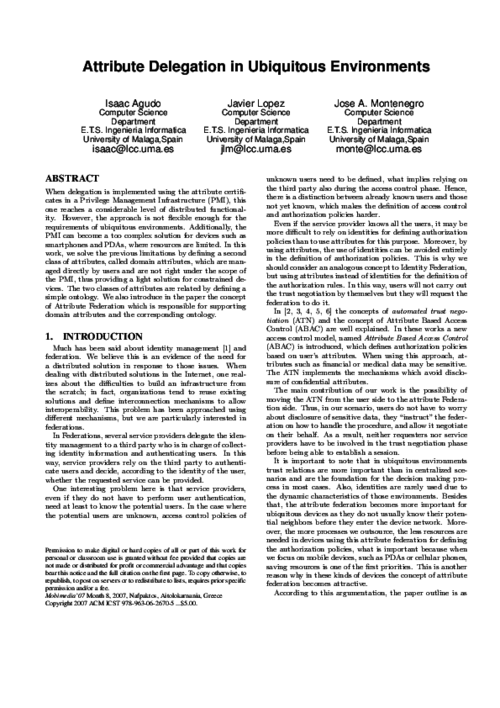
5th international conference on Computer systems and technologies (CompSysTech ’04), ACM, pp. 1-6, 2004. DOI
Abstract
With the grown of internet and distributed applications, security requirements are going inherent to the software development process. Each time one communicates with some other one there are relevant security risk that must be taken in account. This is what is happening in the new soft-ware applications using client/server architecture. We propose including security requirements at the top level of development process, together with functional requirements because they are much related. With this information we are able to extract all communication protocols that are involved in our application and their associated security goals. This is the input to a verification phase in which we look for security flaws. The last step, and the more useful (and the not yet finished) is to use this information to modify our initial specification at the top level of the development process
Sixth European Workshop on Public Key Services, Applications and Infrastructures (EuroPKI’09), LNCS 6391, Springer, pp. 225-238, 2009. DOI
Abstract
Deciding who to trust in the internet of services paradigm is an important and open question. How to do it in an optimal way is not always easy to determine. Trust is usually referred to a particular context whereas a single user may interact in more than one given context. We are interested in investigating how a Federated Reputation System can help exporting trust perceptions from one context to another. We propose a model for deriving trust in online services. In this context, trust is defined as the level of confidence that the service provider holds on the subject interacting with it to behave in a proper way while using the service. Thus, we derive trust by using the reputation values that those users have gained for interacting with these services.
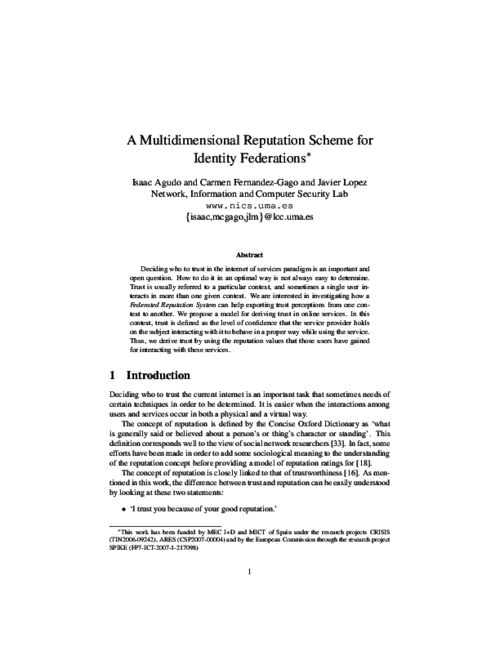
11th Australasian Conference on Information Security and Privacy (ACISP’06), LNCS 4058, Springer, pp. 383-394, 2006. DOI
Abstract
This paper elaborates on a solution to represent authorization and delegation in a graphical way, allowing users to better interpret delegation relationships. We make use of Weighted Trust Graph (WTG) as an instrument to represent delegation and authorization, extending it to cope with more complicated concepts, and providing a graphical representation of the level of confidence that exists between two entities regarding a resource or attribute. We represent the level of confidence for each pair of entities as a point in an axis diagram, as a set of points, or as a set of triangular regions depending on the accuracy we need. Then, we use the same diagram to represent the set of acceptable confidence level, that we call authorization policy set. In this way, a single diagram can be used to decide about authorization, thus providing a powerful tool for systems in which interaction of users is needed.

XIV Jornadas de Ingeniería Telemática (JITEL 2019), 10/2019.
Abstract
En los nuevos paradigmas de movilidad surgidos durante los últimos años y en aquellos aún por llegar ha quedado patente la necesidad de modernizar la infraestructura viaria y los elementos de señalización y gestión del tráfico. En el presente trabajo se presenta una propuesta para esta nueva generación de dispositivos de gestión del tráfico: un prototipo de semáforo inteligente conectado que implementa diversas medidas de seguridad. Además de las tradicionales señales luminosas, los usuarios de la vía pueden conocer a través de sus dispositivos el estado del semáforo, además de otra información complementaria a través de la difusión de mensajes BLE firmados con criptografía de curva elíptica. A su vez, el semáforo puede ser gestionado remotamente a través de la tecnología LTE Cat M1 protegida por TLS. Esto abre la puerta, entre otros, a facilitar el tránsito de los vehículos de emergencia cuando estos se acercan a un cruce o modificar el tiempo de los estados del ciclo en función de las necesidades del tráfico.
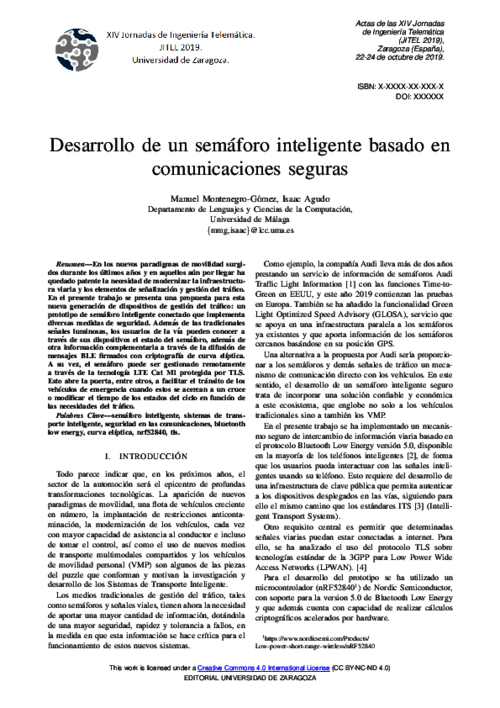
1st International Workshop on Security and Trust for Applications in Virtualised Environments (STAVE 2011), C. Lee, J-M. Seigneur, J. J. Park, and R. R. Wagner Eds., Communications in Computer and Information Science 187, Springer, pp. 190-197, June, 2011. DOI
Abstract
In this paper we identify some areas where cryptography can help a rapid adoption of cloud computing. Although secure storage has already captured the attention of many cloud providers, offering a higher level of protection for their customer’s data, we think that more advanced techniques such as searchable encryption and secure outsourced computation will become popular in the near future, opening the doors of the Cloud to customers with higher security requirements.

5th International Workshop on Formal Aspects in Security and Trust (FAST’08), LNCS 5491, Springer, pp. 302-315, 2008. DOI
Abstract
When delegation in real world scenarios is considered, the delegator (the entity that posses the privileges) usually passes the privileges on to the delegatee (the entity that receives the privileges) in such a way that the former looses these privileges while the delegation is effective. If we think of a physical key that opens a door, the privilege being delegated by the owner of the key is opening the door. Once the owner of the key delegates this privilege to another entity, by handing over the key, he is not able to open the door any longer. This is due to the fact that the key is not copied and handed over but handed over to the delegatee. When delegation takes place in the electronic world, the delegator usually retains also the privileges. Thus, both users have them simultaneously. This situation, which in most cases is not a problem, may be undesirable when dealing with certain kind of resources. In particular, if we think of finite resources, those in which the number of users accessing simultaneously is finite, we can not allow that a user delegating his access privilege is also granted access when the delegation if effective. In this paper we propose an approach where each user is delegated an access quota for a resource. If further delegating of the delegated quota occurs, this is subtracted from his quota. That is, when delegating, part of the quota remains with the delegator and another part goes to the delegatee. This allows a more fairly access to the resource. Moreover, we show that this approach can also be applied to any kind of resources by defining appropriate authorization policies.
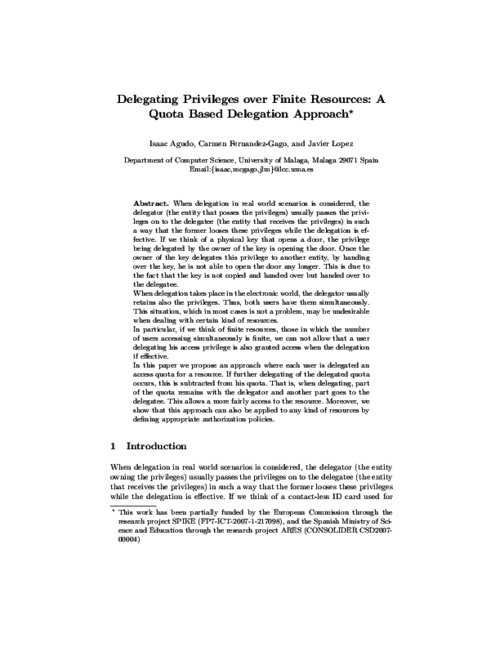
VIII Reunión Española sobre Criptología y Seguridad de la Información (VIII RECSI), pp. 225-235, Sep 2004.
Concurrency and Computation: Practice and Experience, vol. 21, John Wiley & Sons, pp. 1389-1403, July, 2009. DOI
Abstract
Concurrent access control is an old problem in many fields in Computer Science. It has been solved in many languages and systems, using mechanisms like monitors or priority queues. Nowadays computers implement multi-core capabilities. This means that they are virtually capable of execution of processes in parallel. This requires new techniques and open new issues in the field of concurrent access control. Moreover, most operating systems are multi-user; thus, we have to focus on a multi-processor multi-user scenario. Trust becomes a paramount aspect when building distributed applications; the same applies on a lower scale in modern computers. We propose the use of a trust graph that keeps record of the trust relationships of the system and helps in deciding on concurrent access requests. The information encoded in the graph will be used both in order to decide on the access requests and to order granted requests in terms of their associated trust level
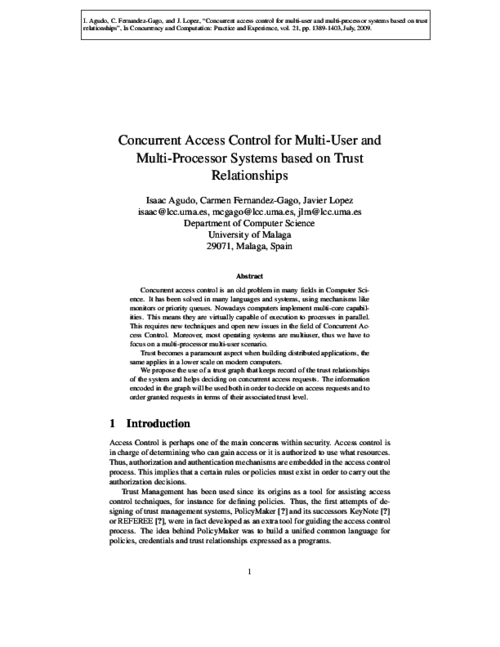
10th IFIP TC-6 TC-11 International Conference on Communications and Multimedia on Security (CMS’06), LNCS 4237, Springer, pp. 54-66, October, 2006. DOI
Abstract
This paper presents a model for delegation based on partial orders, proposing the subclass relation in OWL as a way to represent the partial orders. Delegation and authorization decisions are made based on the context. In order to interact with the context, we define the Type of a credential as a way to introduce extra information regarding context constraints. When reasoning about delegation and authorization relationships, our model benefits from partial orders, defining them over entities, attributes and the credential type. Using these partial orders, the number of credentials required is reduced. It also classifies the possible criteria for making authorization decisions based on the context, in relation to the necessary information.
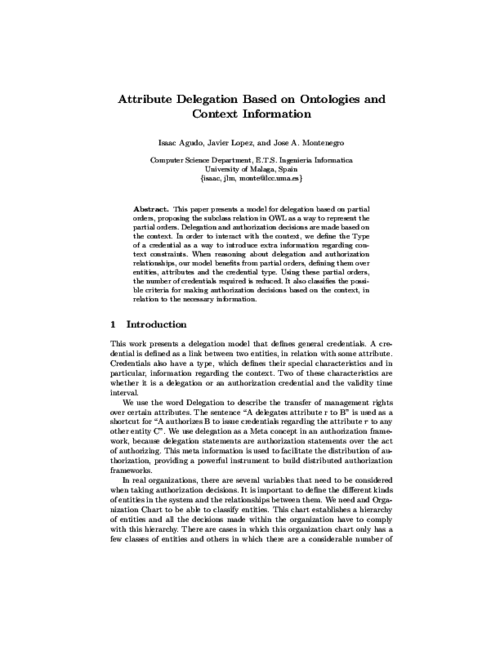
 ]
]